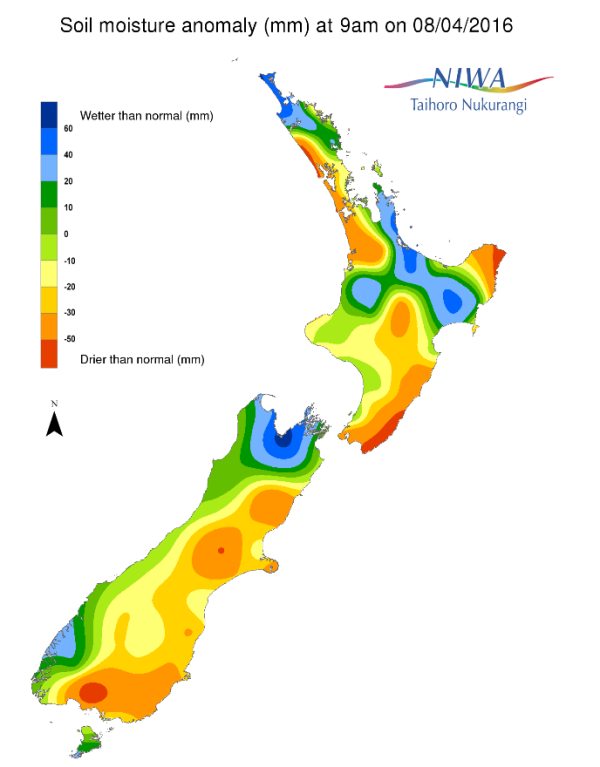A weekly update describing soil moisture across the country to help assess whether severely to extremely dry conditions are occurring or imminent. Regions experiencing these soil moisture deficits are deemed “hotspots”. Persistent hotspot regions have the potential to develop into drought.
Across the North Island, soil moisture levels have generally remained the same or decreased slightly when compared to this time last week. Slight decreases were observed in Taranaki, Manawatu-Whanganui, Waikato, and from the Coromandel Peninsula to northern Hawke’s Bay. An exception was southern Auckland, where a minimal soil moisture increase occurred. The driest soils compared to normal for this time of the year are found in western Kaipara, far northeastern Gisborne and in eastern Wairarapa while the wettest are found in northern Northland and the southern Coromandel Peninsula.
Across the South Island, soil moisture levels have decreased slightly in the north but increased slightly in the south compared to this time last week. The most significant decreased occurred in central Hurunui while the most significant increased occurred from eastern Southland into Otago. The driest soils compared to normal for this time of the year are found in northern Canterbury while the wettest are found in Tasman, Nelson, and Marlborough.
Outlook
Strong high pressure over the North Island will give way to an approaching sub-tropical low pressure system this weekend. Areas of rain, some heavy, will overspread Northland later in the day on Saturday before spreading into Auckland Saturday night. Rain of a lighter intensity will continue to move southeastward into Waikato, Bay of Plenty, Hawke’s Bay, and Gisborne from Sunday into early Monday. Rainfall will be heaviest across Northland and Auckland with totals of 10 to 25 mm common; isolated higher amounts to 50 mm are possible, especially in Northland. Rain across Waikato will generally be 10 to 20 mm with totals mostly less than 10 mm from Bay of Plenty to Hawke’s Bay. Generally dry weather is expected across the rest of the North Island this weekend. Isolated showers are possible from Gisborne to Wellington on Monday and Tuesday with no more than a few millimetres of rain. Isolated showers may pass over parts of Northland, Auckland and the Coromandel in the mid- and late-week as the wind shifts toward the east. The driest region over the next week will be from Taranaki eastward through Manawatu-Whanganui and Wellington-Wairarapa; rainfall may be less than 5 mm across this area. The heaviest falls will be across Northland and Auckland (mostly from this weekend’s rain event) with weekly rain totalling 10 to 25 mm (locally higher).
Across the South Island, rain will return to the Fiordland and the southern West Coast on Saturday. Saturday night, rain will streak farther up the West Coast while patchy rain affects the remainder of Southland and parts of Otago. Wet weather is forecast to continue across lower Canterbury and along the West Coast on Sunday. From Fiordland to the West Coast, 25 to 50 mm of rain is expected this weekend; totals of 5 to 10 mm are expected elsewhere. A dry southerly will keep much of the island dry on Monday and Tuesday. Light falls of less than 5 mm are possible in the far southwest on Wednesday and Thursday. Heavier rain may return to the southwest on Friday into next weekend. The driest region over the next week will be from mid Canterbury on northward; many locales will receive less than 5 mm with some places seeing no rainfall at all. The wettest place over the next week will be Fiordland with totals of 25-75 mm common.
Soil Moisture
The North Island continues to show great variance in soil moisture for this time of the year, with areas of much wetter and drier than normal soil. Hotspot areas remain present across southern Hawke’s Bay, much of Wellington-Wairarapa, northern and southeastern Waikato, far southwestern Northland, western Auckland, and northeast coastal Gisborne. A hotspot area in far northeastern Bay of Plenty has dissipated over the past week. Current hotspot areas are forecast to worsen over the next week across the central and southern North Island with new hotspot development possible. Hotspot areas to the north are forecast to generally remain the same.
On the South Island, hotspot areas remain present across much of Canterbury and parts of eastern Otago. An area in central Southland remains near the hotspot threshold. Over the next week, existing hotspots are forecast to expand. New development is likely, especially along the east coast.
Background
Hotspot Watch a weekly advisory service for New Zealand media. It provides soil moisture and precipitation measurements around the country to help assess whether extremely dry conditions are imminent.
Soil moisture deficit
The amount of water needed to bring the soil moisture content back to field capacity, which is the maximum amount of water the soil can hold.
Soil moisture anomaly
The difference between the historical normal soil moisture deficit (or surplus) for a given time of year and actual soil moisture deficits.
Definitions
“Extremely” and “severely” dry soils are based on a combination of the current soil moisture status and the difference from normal soil moisture (see soil moisture maps at https://www.niwa.co.nz/climate/nz-drought-monitor/droughtindicatormaps).
Soil moisture anomaly maps
Pictured below are soil Moisture Anomaly Maps, relative to this time of year. The maps show soil moisture anomaly for the past two weeks.


